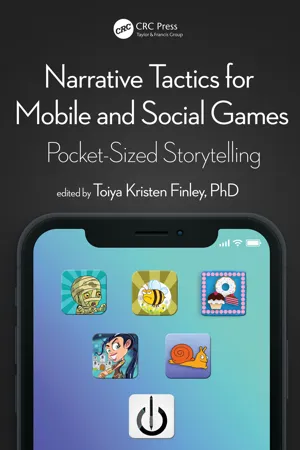Story delivery vs. story
Story delivery = narrative design
A Game’s Narrative Design
Worldbuilding
Narrative structure
Character and creature design
Environmental narrative
Location design
Story integration into gameplay and mechanics
Overall tone
Dialogue delivery
Cutscenes vs. animatics vs. neither
UI design
Quest or mission design and structure
Sound design
Story delivery and the player’s imagination
Mystery Match (2015)
Plague Inc. (2012)
The player’s imagination and emotions
Getting the entire team involved with story delivery
Coming Up with a Plan
Conclusion
The story delivery checklist
Tips for working with the development team
Here’s a premise for you:
It’s you against the world...
A fight for survival, you have to wipe out all of your enemies, or they’ll obliterate you from existence. You must do whatever you can to stay alive. Outwit them before they figure out your plans. If you want to defeat them—all of humanity—you’re going to have to do destructive things, horrible things.
But you’ll get to live as a conqueror if you do.
Would you consider the above premise story oriented? (We’ll get back to this a little later.)
Get into a discussion about what makes videogames special, and it’s not long before someone brings up that they’re an active medium, unlike prose fiction, comics/manga, film, animation, or TV. The game involves players who are involved in what happens. Through gameplay and controls, players change what’s happening to the world. In a level, they may destroy every building on the map while hunting aliens. Or they may help all of the nonplayer characters (NPCs) in a town capture or kill a group of bandits. They can interact with certain NPCs and choose responses in dialogue trees. Other choices they make might alter the story’s plot or characters’ lives. Videogames, an active medium, feed player agency.1
In addition to player agency, many console, PC, and online games offer increasingly realistic levels of immersion. They place player characters (PCs)—and players, by extension—into a world where players can roam around and explore. Whether that world is rendered in 2D, isometric 3D, 3D, or VR, it has terrains to walk, run, or climb. Players can look at their screens and see NPCs interact with player characters. They might hear a “BOOM!” followed by shouting behind them, alerting them to backtrack to see what the excitement’s about. Through mechanics, sound, animation, art, and other assets, these traditional games2 have multiple techniques that engage players and hook their interest.
Because of technological limitations and smaller storage capacities on smartphones and tablets, mobile and social games have historically been at a disadvantage when it comes to facilitating immersion and player agency. With the advancements in mobile devices, more and more mobile and social games have the characteristics of these worlds found in console, PC, and online games. However, many still can’t render the complexity of the worlds we’ve become accustomed to in traditional videogames. They don’t allow players to complete a mission based upon a certain play style (like stealth mode or no killing), which would in turn affect variable story and gameplay outcomes. They don’t let players side with one character over another, unlocking a new branch in the story. And they don’t have multiple endings. In effect, many of these games have linear stories the player doesn’t influence at all.
These technological disadvantages of mobile games can lead to a storytelling consequence: players feel as if they’re watching a story instead of participating in it. Players also complain that the typical mobile game does not integrate the story, world, and characters into its gameplay. Additionally, some of the techniques we use in traditional games, like the cutscene, may not be feasible in mobile. A lot of players dread cutscenes in traditional and mobile games because they take away from the action and gameplay—the parts of the game they care about the most. A cutscene in a mobile game may be even more frustrating because it cuts into the limited time players have for sessions while waiting in the doctor’s office. Or they don’t feel a part of the game’s story because there’s no avatar representing them in the game, and the PC is unseen. Even worse, developers don’t take the game’s narrative design into account at all.
But all of these are solvable problems. We can make mobile and social games player-centric even though we don’t have the same technological advantages of traditional games.
I was working as a narrative designer with Relevant Games on a mobile game that was never released. Our story was interstitial between the gameplay segments and linear with no player choices. We realized the unseen PC was passive and at the whims of the NPCs’ decision-making. As we puzzled over fixing this problem, creative director Joshua Mills asked a provocative question, “How do we keep the player at the heart of the story?” Whether the game is story-oriented or not, there are tricks we can use that aid players in feeling like they’re driving the action and/or plot.
There are a few things we need to keep in mind: (1) we can think of mobile and social games as a game space, (2) we need to remember that narrative design is just as essential in mobile and social games as it is in traditional games, and (3) players’ imaginations are powerful tools that aid us in telling stories. We can use great narrative design to keep players engaged in the game space and use that game space to reflect every aspect of the story.
Story delivery vs. story
We can use the game’s space for its story delivery.
Storytelling goes beyond dialogue and cutscenes. Storytelling is more than words, and a game’s narrative design can use any aspect of the game to contribute to its storytelling. A common way for explaining the concept of narrative design is “It serves as a bridge between gameplay and story.” That’s pretty good, but I don’t think it’s quite complete. Suggesting there needs to ...
